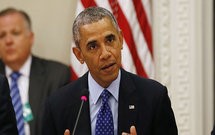 U.S. President Barack Obama confirmed a week's worth of speculation Wednesday night on his administration's strategy to combat the Islamic State. As expected, the basic idea is for the United States to lead an expansion of the air campaign in Iraq and extend it to Syria, treating the militant-trodden river valleys as a single battle space.
U.S. President Barack Obama confirmed a week's worth of speculation Wednesday night on his administration's strategy to combat the Islamic State. As expected, the basic idea is for the United States to lead an expansion of the air campaign in Iraq and extend it to Syria, treating the militant-trodden river valleys as a single battle space.
Without nuancing the necessary role of intelligence assets and special operations forces, Obama tried to reassure the American public that he would not commit boots on the ground to another Middle Eastern maelstrom but that he had a plan nonetheless to contain an army of particularly brutal jihadists.
The United States has sought the support and assistance of its international partners in an attempt to lessen the military and political burden of the operation. During the Sept. 4-5 NATO summit, Washington failed to organize an official NATO intervention against the Islamic State, but it did shore up the support of a core coalition of nine countries (the United Kingdom, France, Germany, Canada, Australia, Turkey, Italy, Poland and Denmark). On Tuesday, U.S. Secretary of State John Kerry also mentioned that there was a broader coalition of more than 40 countries that would be supporting the operations. It is not clear yet how substantial the commitment of any of these countries will be, but additional air assets, logistical support and basing will be some of the main elements in expanding operations in volume and in geographic reach.
Obama's speech was essentially a political public relations effort, timed only after Iraqi leaders managed to pull together a government and ahead of November U.S. midterm elections. With most U.S. congressmen reluctant to vote on anything with a hint of controversy this close to the election, yet many all too prone to condemn the U.S. president for not consulting them enough, Obama was obviously trying to kill several birds with one stone in this speech. Domestic politics aside, this is a strategy that faces unavoidable imperfections as the United States tries to meld contradictory political and military objectives for the region.
The first and most glaring contradiction lies in the combination of attacking Islamic State targets by air while selectively arming and training Syrian rebels on the ground, not to mention that the United States will be working with Iranian proxies in Iraq and pro-Saudi actors in Syria. On the surface, and as Obama laid out, this makes perfect sense: The United States is not about to commit its own combat troops to engage with the Islamic State, so it must partner with local Sunni forces to degrade Islamic State fighters on the ground while it strikes from the air. Just as the United States is making gradual progress in standing up a coherent fighting force in Iraq through the Kurdish peshmerga, Sunni tribal forces and Iraqi army soldiers, it will be looking to do the same in Syria.
But if only Syria offered such a neat solution. On the contrary, no matter how carefully the United States tries to pick and choose whom it trains and arms in Syria, the Salafist-jihadist fighters are the ones who dominate the battlefield and are thus the most capable of beating back their Islamic State rivals. There is also no guarantee that the pockets of nominally moderate rebels concentrated around Aleppo are going to apply their weaponry and training toward combatting the Islamic State primarily when their priority is to break out of stalemate on the battlefield and get closer to the goal of toppling the regime of Bashar al Assad.
This brings the U.S. strategy to the next big contradiction: How does it back the Syrian rebels enough to degrade the Islamic State but not so much that it risks proliferating power vacuums for radicals to fill and destroying a working relationship with Iran? The U.S. administration will predictably expend a great deal of energy justifying an expansion of airstrikes into Syria and refuting claims that it is aiding a dictator. The announcement to arm Syrian rebel factions is a piece of that effort. But a meaningful effort to arm and train Sunni rebels in Syria could well develop into an existential threat for the Iran-backed Syrian regime. This would of course not be welcomed by Iran, with which the United States is engaged in a critical negotiation designed to put their long-hostile relationship on a stable tracking.
How much of the strategy is public relations versus reality will be seen in the coming days and weeks on the battlefield. The target set in Syria will offer a major clue as to whether quiet U.S.-Iranian coordination is proceeding via backchannels. If major energy infrastructure and surface-to-air missile sites are destroyed, thus seriously degrading both the Syrian regime's capabilities and economic assets of the Islamic State, the evident lack of an understanding between Damascus and Washington will be sure to have negative consequences for U.S. negotiations with Iran. On the other hand, if the United States focuses its targeting on Islamic State concentrations along the river valleys to cut the group's eastern supply lines while expanding the offensive in Iraq, the kabuki theater will continue.
Courtesy : Stratfor (www.stratfor.com)